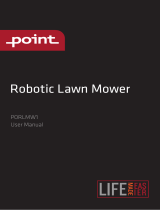
XI
Chapter 1 Planning Ahead ............................................................................................................................................. 1
Planning Perimeter Wire Installation.................................................................................................................................. 1
Lawn Types: What does your lawn look like? .................................................................................................................... 1
“Separated Zones” Type Lawn .......................................................................................................................................... 3
Select Base Station Location ............................................................................................................................................ 4
Determine Power Box Location ......................................................................................................................................... 5
Planning the Perimeter Wire’s Layout ............................................................................................................................... 5
Chapter 2 Initial Setup .................................................................................................................................................... 7
Perimeter Wire Setup ........................................................................................................................................................ 7
Special cases of Perimeter Wire setup .............................................................................................................................. 8
Separated Zone(s) ........................................................................................................................................................... 12
Fastening Perimeter Wire to the Ground ......................................................................................................................... 13
Back at the Base Station – Completing the Perimeter Wire Setup .................................................................................. 13
Assembling the Base Station ........................................................................................................................................... 14
Placing The Base Station ................................................................................................................................................ 15
Installing the Power Box .................................................................................................................................................. 16
At the Power Box Location: ............................................................................................................................................. 16
Chapter 3 Preparing Robomow ................................................................................................................................... 17
Adjust the Cutting Height ................................................................................................................................................. 17
Insert the Fuse ................................................................................................................................................................ 17
One-Time Setup (Step By Step) ...................................................................................................................................... 17
After Setup is Complete .................................................................................................................................................. 20
Chapter 4 Robomow Operation ................................................................................................................................... 21
Automatic Operation ........................................................................................................................................................ 21
Menu Structure ................................................................................................................................................................ 22
Lawn Options ................................................................................................................................................................... 22
Mower Options................................................................................................................................................................. 30
Manual Operation ........................................................................................................................................................... 33
Chapter 5 Using the Power Box .................................................................................................................................. 34
Power Box Alerts ............................................................................................................................................................. 34
To Turn Buzzer On/Off ..................................................................................................................................................... 34
To Disable the Automatic Operation ................................................................................................................................ 34
Chapter 6 Charging ...................................................................................................................................................... 35
Charging During the Season ........................................................................................................................................... 35
Charging Out of Season .................................................................................................................................................. 35
Chapter 7 Troubleshooting ......................................................................................................................................... 37
Text error-messages ........................................................................................................................................................ 37
Error Messages And Corrective Actions .......................................................................................................................... 37
Other Problems ............................................................................................................................................................... 40
Chapter 8 Specifications .............................................................................................................................................. 43
Chapter 9 Maintenance and Storage .......................................................................................................................... 44
Maintenance of the Mowing Deck ................................................................................................................................... 44
Maintenance of the Blades .............................................................................................................................................. 45
Disposing of the Old Battery Pack ................................................................................................................................... 46
Splicing the Perimeter Wire ............................................................................................................................................. 46
Maintenance of the Base Station Area ............................................................................................................................ 46
Storing the Mower during Winter ..................................................................................................................................... 46
Winter Service ................................................................................................................................................................. 46
Chapter 10 Accessories ................................................................................................................................................. 47
Chapter 11 Tips for maintaining your lawn .................................................................................................................. 48
Warranty Card























